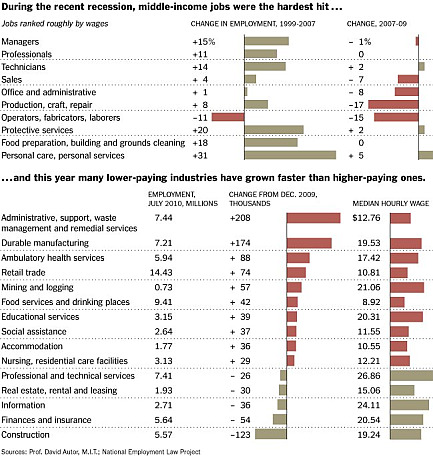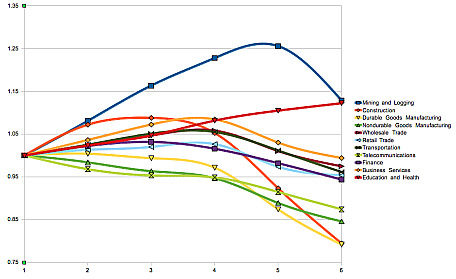Sign up for the daily CJR newsletter.
The New York Times does good work today, looking at an issue that hasn’t received enough attention: “the quality of the jobs being created and what that might say about the opportunities available to workers when the recession finally settles.”
This story has a lot of good elements, including interesting research reports, some (recent) historical context, and real live people who’ve managed to find work—as a home health aide and a waitress at an Arkansas truck stop.
Those women could easily be portrayed as success stories, landing jobs while the unemployment rate remains so high. But, unfortunately, things just aren’t that neat. As the Times tells it:
Both women, however, took large pay cuts from their old jobs — Ms. Ings worked for a wholesale tuxedo distributor, Ms. Nelson was a secretary. And both remain worried about how they will make ends meet in the long run.
The Times points to some interesting background to help explain the current situation, highlighting the way “job growth had become increasingly polarized in this country” before the recession:
High-paid occupations that require significant amounts of education and training grew rapidly alongside low-wage, service-type jobs that do not, according to David Autor, a labor economist at the Massachusetts Institute of Technology.
While that trend continued and intensified, what Autor calls “middle-skill, middle-wage” jobs lost out.
The NYT story uses two recent studies for support. One finds that, from 2007 to 2009, “there was relatively little net change in total employment for both high-skill and low-skill occupations, while employment plummeted in so-called middle-skill occupations.”
The second analysis, from the National Employment Law Project, takes a different look at the situation. The Times does well to point out that the source is a liberal advocacy group and that its focus is on whole industries, even though there may be differences within them. But the results are still important:
It found that job expansion to this point had been skewed toward industries with median wages that are low to middling, with a disproportionate share of job growth happening in industries whose median wages fell below $15 an hour.
That’s not good, as the health aide and the waitress explain vividly.
There are also a couple of great charts, offering stark evidence of the way middle-income jobs were hit hardest by the recession, and of how many lower-paying industries are growing faster than higher-paying ones:
Over at The Washington Independent, where I used to work, Annie Lowrey uses some related data to weigh in on the big—well, one of the big—debates among economists over whether unemployment is “cyclical” or “structural.”
Lowrey does a good job synthesizing the debate, and comes down somewhere in the middle:
Most sectors have suffered from the turndown, but job losses are concentrated in some industries: In residential construction, they are down 38 percent since 2006. (Between Aug. 2007 and Dec. 2009, unemployment in construction quintupled from about 5 percent to about 25 percent.) In health care and education, however, jobs are up.
Lowrey used data from the Bureau of Labor Statistics to chart total jobs in major sectors since 2005. The result looks a bit fuzzy here, but the colors are nice, and the analysis is clear:
As she explains:
Most sectors — retail trade, business services, wholesale trade, finance — have had moderate job losses one could reasonably chalk up to an economy-wide lack of demand. Let’s think of those as sectors characterized mostly by cyclical job loss. Then, there is manufacturing and construction. Jobs there have taken a nose dive, and the problem seems to be structural. Moreover, the job gains in education and health might [sic] thought to be structural as well. (Mining and logging isn’t an industry I know a lot about, so I’m not sure what’s going on there.)
It’s a nice complement to the Times story. And both are good reminders that there are still lots and lots of stories to be told on the employment beat.
Has America ever needed a media defender more than now? Help us by joining CJR today.








